Retrieval of Nitrogen Content in Apple Canopy Based on Unmanned Aerial Vehicle Hyperspectral Images Using a Modified Correlation Coefficient Method
Abstract
:1. Introduction
2. Materials and Methods
2.1. Study Area
2.2. Data Acquisition and Preprocessing
2.2.1. Hyperspectral Image Acquisition and Preprocessing
2.2.2. Apple Canopy Leaf Collection and Nitrogen Content Determination
2.3. Methodology Description
2.3.1. Extraction of Canopy Hyperspectral Images Based on NDCSI
2.3.2. Screening of Sensitive Wavelengths Using MCCM Method
- (1)
- Correlation coefficient calculation: a correlation analysis was conducted among the spectral data from the UAV hyperspectral image and nitrogen content.
- (2)
- Location of first sensitive wavelength determined: the wavelengths that are higher than 0.5 were correlated with the nitrogen content, screened out and arranged according to the wavelength order. The first wavelength with correlation higher than 0.5 was identified as the first sensitive wavelength.
- (3)
- Nitrogen content sensitive wavelength screening: the wavelength autocorrelation threshold was set, the correlation between the first sensitive wavelength and the remaining wavelengths was analyzed, and the position of the second sensitive wavelength was determined according to the threshold. A correlation analysis was conducted among the spectral data of the determined second sensitive wavelength and those of other wavelengths, and the position of the third sensitive wavelength was determined according to the autocorrelation threshold between the wavelengths. This step was repeated until all bands were covered, and finally all sensitive wavelengths of nitrogen content within the band range of the hyperspectral data were determined.
2.3.3. Construction of Spectral Characteristic Parameters
2.3.4. Model Establishment and Testing
3. Results
3.1. Determination of NDCSI Threshold and the Extraction of Apple Canopy Hyperspectral Images
3.2. Spectral Characteristics Analysis of Tree Canopy
3.3. Sensitive Wavelength Screening and Spectral Parameter Construction of Nitrogen Content Based on MCCM
3.3.1. Correlation Analysis between Canopy Spectral Reflectance and Nitrogen Content
3.3.2. Threshold Determination and Sensitive Wavelength Screening Based on MCCM
3.3.3. Construction of Spectral Parameters
3.4. Construction and Verification of Apple Tree Canopy Nitrogen Retrieval Model
4. Discussion
5. Conclusions
Author Contributions
Funding
Institutional Review Board Statement
Informed Consent Statement
Data Availability Statement
Conflicts of Interest
References
- Bergera, K.; Verrelst, J.; Féret, J.; Wang, Z.; Wocher, M.; Strathmann, M.; Danner, M.; Mauser, W.; Hank, T. Crop nitrogen monitoring: Recent progress and principal developments in the context of imaging spectroscopy missions. Remote Sens. Environ. 2020, 242, 11758–11775. [Google Scholar] [CrossRef]
- Bhadra, S.; Sagan, V.; Maimaitijiang, M.; Maimaitiyiming, M.; Newcomb, M.; Shakoor, N.; Mockler, T. Quantifying Leaf Chlorophyll Concentration of Sorghum from Hyperspectral Data Using Derivative Calculus and Machine Learning. Remote Sens. 2020, 12, 2082. [Google Scholar] [CrossRef]
- Padalia, H.; Sinha, S.K.; Bhave, V.; Trivedi, N.K.; Kumar, A.S. Estimating canopy LAI and chlorophyll of tropical forest plantation (North India) using Sentinel-2 data. Adv. Space Res. 2020, 65, 458–469. [Google Scholar] [CrossRef]
- Huang, Y.; Chen, Z.; Yu, T.; Huang, X.; Gu, X. Agricultural remote sensing big data: Management and applications. J. Int. Agric. 2018, 17, 1915–1931. [Google Scholar] [CrossRef]
- Hansen, P.M.; Schjoerring, J.K. Reflectance measurement of canopy biomass and nitrogen status in wheat crops using normalized difference vegetation indices and partial least squares regression. Remote Sens. Environ. 2003, 86, 542–553. [Google Scholar] [CrossRef]
- Cammarano, D.; Fitzgerald, G.; Basso, B.; O’Leary, G.; Chen, D.; Grace, P.; Fiorentino, C. Use of the Canopy Chlorophyll Content Index (CCCI) for the remote estimation of wheat nitrogen content in rainfed environments. Agron. J. 2011, 103, 1597–1603. [Google Scholar] [CrossRef]
- Zhao, C.; Wang, Z.; Wang, J.; Huang, W. Relationships of leaf nitrogen concentration and canopy nitrogen density with spectral features parameters and narrow-band spectral indices calculated from field winter wheat (Triticum aestivum L.) spectra. Int. J. Remote Sens. 2012, 33, 3472–3491. [Google Scholar] [CrossRef]
- Lee, H.; Wang, J.; Leblon, B. Intra-Field Canopy Nitrogen Retrieval from Unmanned Aerial Vehicle Imagery for Wheat and Corn Fields. Can. J. Remote Sens. 2020, 46, 454–472. [Google Scholar] [CrossRef]
- Amirruddin, A.D.; Muharam, F.M. Evaluation of linear discriminant and support vector machine classifiers for classification of nitrogen status in mature oil palm from SPOT-6 satellite images: Analysis of raw spectral bands and spectral indices. Geocarto Int. 2018, 34, 735–749. [Google Scholar] [CrossRef]
- Croft, H.; Arabian, J.; Chen, J.M.; Shang, J.; Liu, J. Mapping within-field leaf chlorophyll content in agricultural crops for nitrogen management using Landsat-8 imagery. Precis. Agric. 2020, 21, 856–880. [Google Scholar] [CrossRef] [Green Version]
- Zhou, X.; Zhang, J.; Chen, D.; Huang, Y.; Kong, W.; Yuan, L.; Ye, H.; Huang, W. Assessment of Leaf Chlorophyll Content Models for Winter Wheat Using Landsat-8 Multispectral Remote Sensing Data. Remote Sens. 2020, 12, 2574. [Google Scholar] [CrossRef]
- Mananze, S.; Pôças, I.; Cunha, M. Retrieval of Maize Leaf Area Index Using Hyperspectral and Multispectral Data. Remote Sens. 2018, 10, 1942. [Google Scholar] [CrossRef] [Green Version]
- Poblete-Echeverría, C.; Olmedo, G.; Ingram, B.; Bardeen, M. Detection and Segmentation of Vine Canopy in Ultra-High Spatial Resolution RGB Imagery Obtained from Unmanned Aerial Vehicle (UAV): A Case Study in a Commercial Vineyard. Remote Sens. 2017, 9, 268. [Google Scholar] [CrossRef] [Green Version]
- Zarco-Tejada, P.J.; Morales, A.; Testi, L.; Villalobos, F.J. Spatio-temporal patterns of chlorophyll fluorescence and physiological and structural indices acquired from hyperspectral imagery as compared with carbon fluxes measured with eddy covariance. Remote Sens. Environ. 2013, 133, 102–115. [Google Scholar] [CrossRef]
- Maes, W.H.; Steppe, K. Perspectives for Remote Sensing with Unmanned Aerial Vehicles in Precision Agriculture. Trends. Plant Sci. 2019, 24, 152–164. [Google Scholar] [CrossRef]
- Weiss, M.; Jacob, F.; Duveiller, G. Remote sensing for agricultural applications: A meta-review. Remote Sens. Environ. 2020, 236, 111402–111421. [Google Scholar] [CrossRef]
- Kalacska, M.; Lalonde, M.; Moore, T.R. Estimation of foliar chlorophyll and nitrogen content in an ombrotrophic bog from hyperspectral data: Scaling from leaf to image. Remote Sens. Environ. 2015, 169, 270–279. [Google Scholar] [CrossRef]
- Zheng, H.; Li, W.; Jiang, J.; Liu, Y.; Cheng, T.; Tian, Y.; Zhu, Y.; Cao, W.; Zhang, Y.; Yao, X. A Comparative Assessment of Different Modeling Algorithms for Estimating Leaf Nitrogen Content in Winter Wheat Using Multispectral Images from an Unmanned Aerial Vehicle. Remote Sens. 2018, 10, 2026. [Google Scholar] [CrossRef] [Green Version]
- Deng, L.; Mao, Z.; Li, X.; Hu, Z.; Duan, F.; Yan, Y. UAV-based multispectral remote sensing for precision agriculture: A comparison between different cameras. Isprs. J. Photogramm. 2018, 146, 124–136. [Google Scholar] [CrossRef]
- Li, Z.; Li, Z.; Fairbairn, D.; Li, N.; Xu, B.; Feng, H.; Yang, G. Multi-LUTs method for canopy nitrogen density estimation in winter wheat by field and UAV hyperspectral. Comput. Electron. Agric. 2019, 162, 174–182. [Google Scholar] [CrossRef]
- Cao, Y.; Jiang, K.; Wu, J.; Yu, F.; Du, W.; Xu, T. Inversion modeling of japonica rice canopy chlorophyll content with UAV hyperspectral remote sensing. PLoS ONE 2020, 15, e0238530. [Google Scholar] [CrossRef]
- Fu, Y.; Yang, G.; Li, Z.; Li, H.; Li, Z.; Xu, X.; Song, X.; Zhang, Y.; Duan, D.; Zhao, C.; et al. Progress of hyperspectral data processing and modelling for cereal crop nitrogen monitoring. Comput. Electron. Agric. 2020, 172, 105321–105334. [Google Scholar] [CrossRef]
- Zhang, J.; Rivard, B.; Rogge, D. The Successive Projection Algorithm (SPA), an Algorithm with a Spatial Constraint for the Automatic Search of Endmembers in Hyperspectral Data. Sensors 2008, 8, 1321–1342. [Google Scholar] [CrossRef] [Green Version]
- Sonobe, R.; Sano, T.; Horie, H. Using spectral reflectance to estimate leaf chlorophyll content of tea with shading treatments. Biosyst. Eng. 2018, 175, 168–182. [Google Scholar] [CrossRef]
- Zhu, H.; Liu, H.; Xu, Y.; Yang, G. UAV-based hyperspectral analysis and spectral indices constructing for quantitatively monitoring leaf nitrogen content of winter wheat. Appl. Opt. 2018, 57, 7722–7732. [Google Scholar] [CrossRef]
- Xu, N.; Tian, J.; Tian, Q.; Xu, K.; Tang, S. Analysis of Vegetation Red Edge with Different Illuminated/Shaded Canopy Proportions and to Construct Normalized Difference Canopy Shadow Index. Remote Sens. 2019, 11, 1192. [Google Scholar] [CrossRef] [Green Version]
- Yu, R.; Zhu, X.; Cao, S.; Xiong, J.; Wen, X.; Jiang, Y.; Zhao, G. Estimation of Chlorophyll Content in Apple Leaves Based on Imaging Spectroscopy. J. Appl. Spectrosc. 2019, 86, 457–464. [Google Scholar] [CrossRef]
- Feng, S.; Xu, T.; Yu, F.; Chen, C.; Yang, X.; Wang, N. Research of Method for Inverting Nitrogen Content in Canopy Leaves of Japonica Rice in Northeastern China Based on Hyperspectral Remote Sensing of Unmanned Aerial Vehicle. Spectrosc. Spect. Anal. 2019, 39, 3281–3287. [Google Scholar]
- Shah, S.; Angel, Y.; Houborg, R.; Ali, S.; McCabe, M. A Random Forest Machine Learning Approach for the Retrieval of Leaf Chlorophyll Content in Wheat. Remote Sens. 2019, 11, 920. [Google Scholar] [CrossRef] [Green Version]
- Lee, H.; Wang, J.; Leblon, B. Using linear regression, Random Forests, and Support Vector Machine with unmanned aerial vehicle multispectral images to predict canopy nitrogen weight in corn. Remote Sens. 2020, 12, 2071. [Google Scholar] [CrossRef]
- Roshani, G.H.; Nazemi, E.; Roshani, M.M. Flow regime independent volume fraction estimation in three-phase flows using dual-energy broad beam technique and artificial neural network. Neural Comput. Appl. 2017, 28, 1265–1274. [Google Scholar] [CrossRef]
- Sattari, M.A.; Roshani, G.H.; Hanus, R.; Nazemi, E. Applicability of time-domain feature extraction methods and artificial intelligence in two-phase flow meters based on gamma-ray absorption technique. Measurement 2021, 168, 108474. [Google Scholar] [CrossRef]
- Hasan, U.; Sawut, M.; Chen, S. Estimating the Leaf Area Index of Winter Wheat Based on Unmanned Aerial Vehicle RGB-Image Parameters. Sustainability 2019, 11, 6829. [Google Scholar] [CrossRef] [Green Version]
- Liu, H.; Zhu, H.; Wang, P. Quantitative modelling for leaf nitrogen content of winter wheat using UAV-based hyperspectral data. Int. J. Remote Sens. 2016, 38, 2117–2134. [Google Scholar] [CrossRef]
- Wang, X.; Zhang, J.; Meng, P.; Yang, H.; Sun, S. Estimation of Nitrogen Content in Walnut Canopy Based on UAV Remote Sensing Image. T Chin. Soc. Agric. Mach. 2021, 52, 178–187. [Google Scholar]
- Liu, T.; Shi, T.; Zhang, H.; Wu, C. Detection of Rise Damage by Leaf Folder (Cnaphalocrocis medinalis) Using Unmanned Aerial Vehicle Based Hyperspectral Data. Sustainability 2020, 12, 9343. [Google Scholar] [CrossRef]
- Noh, H.; Zhang, Q. Shadow effect on multi-spectral image for detection of nitrogen deficiency in corn. Comput. Electron. Agric. 2012, 83, 52–57. [Google Scholar] [CrossRef]
- Aboutalebi, M.; Torres-Rua, A.; Kustas, W.; Nieto, H.; Coopmans, C.; McKee, M. Assessment of different methods for shadow detection in high-resolution optical imagery and evaluation of shadow impact on calculation of NDVI, and evapotranspiration. Irrig. Sci. 2018, 37, 407–429. [Google Scholar] [CrossRef]
- Milas, A.; Arend, K.; Mayer, C.; Simonson, M.; Mackey, S. Different colours of shadows: Classification of UAV images. Int. J. Remote Sens. 2017, 38, 3084–3100. [Google Scholar] [CrossRef]
- Li, M.; Zhu, X.; Bai, X.; Peng, Y.; Tian, Z.; Jiang, Y. Remote Sensing Inversion of Nitrogen Content in Apple Canopy Based on Shadow Removal. Sci. Agric. Sin. 2021, 54, 2084–2094. [Google Scholar]
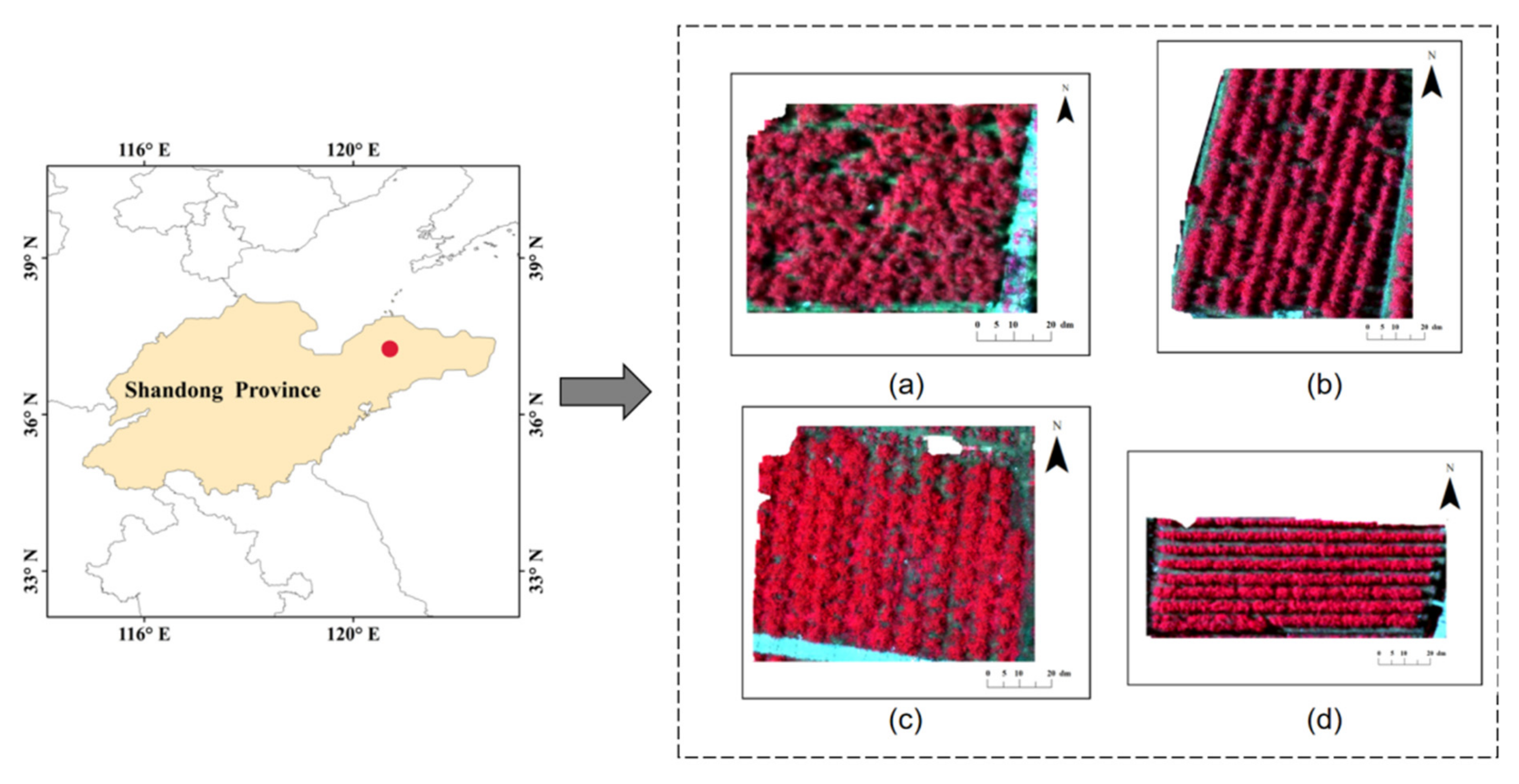
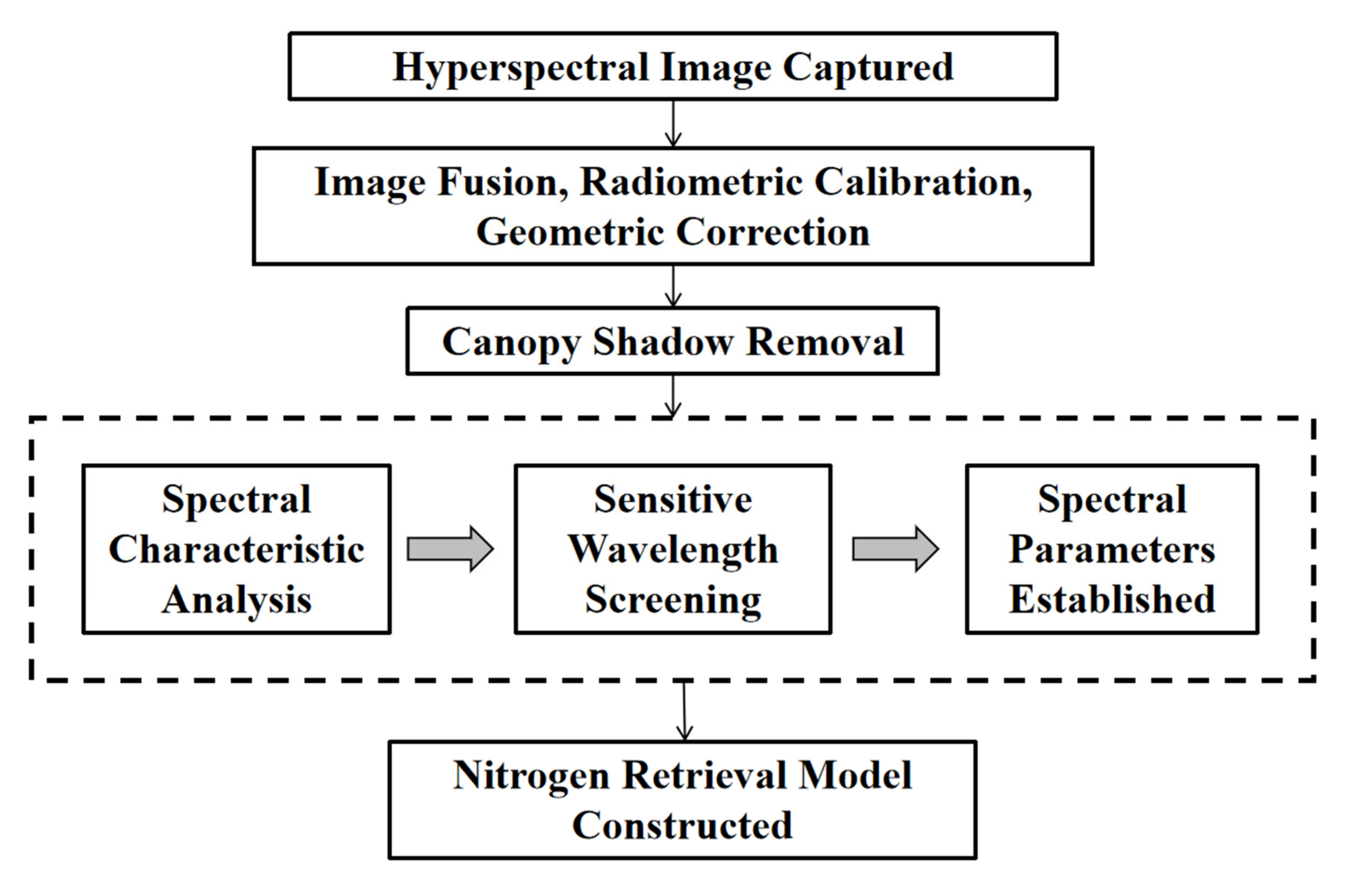
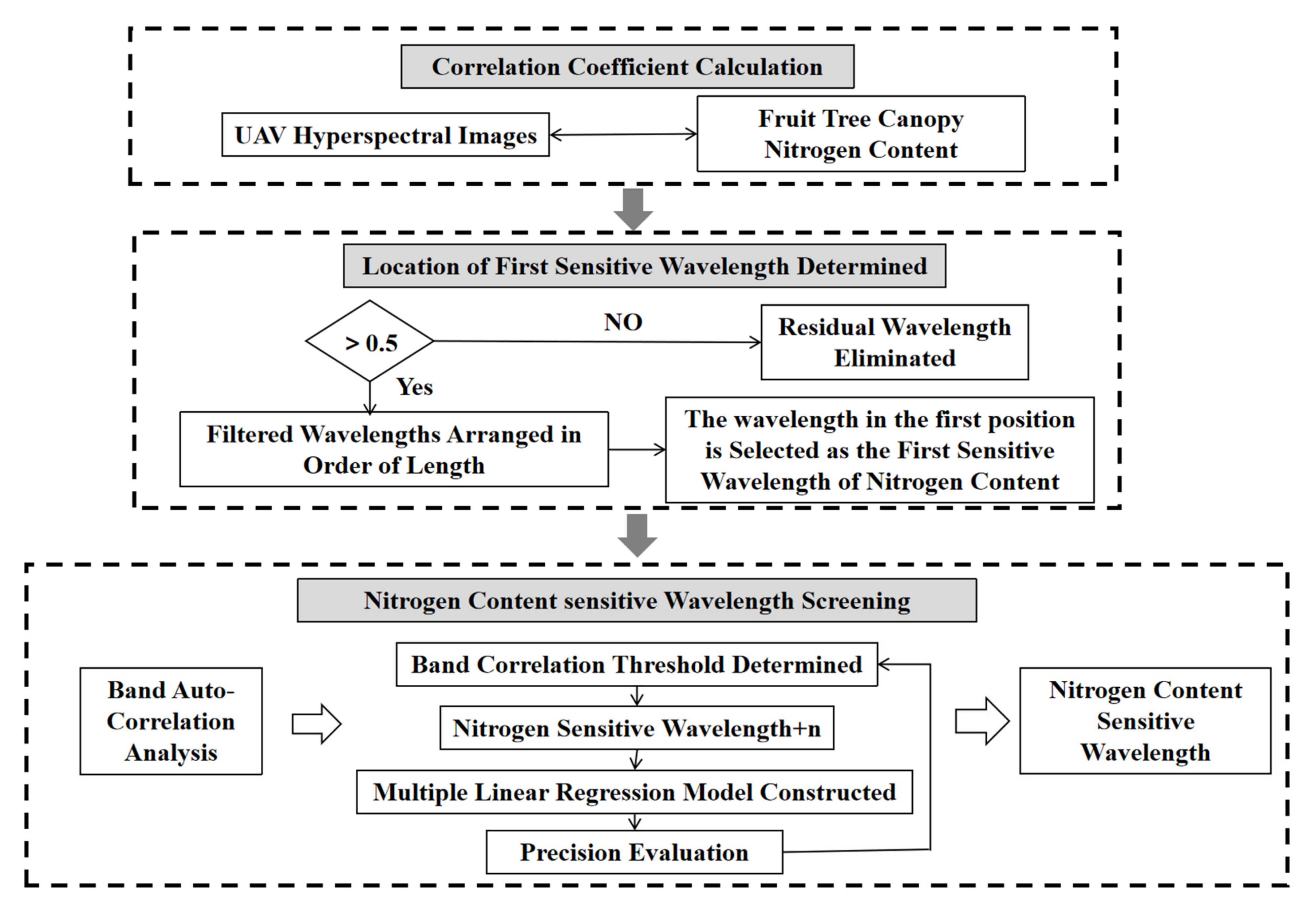
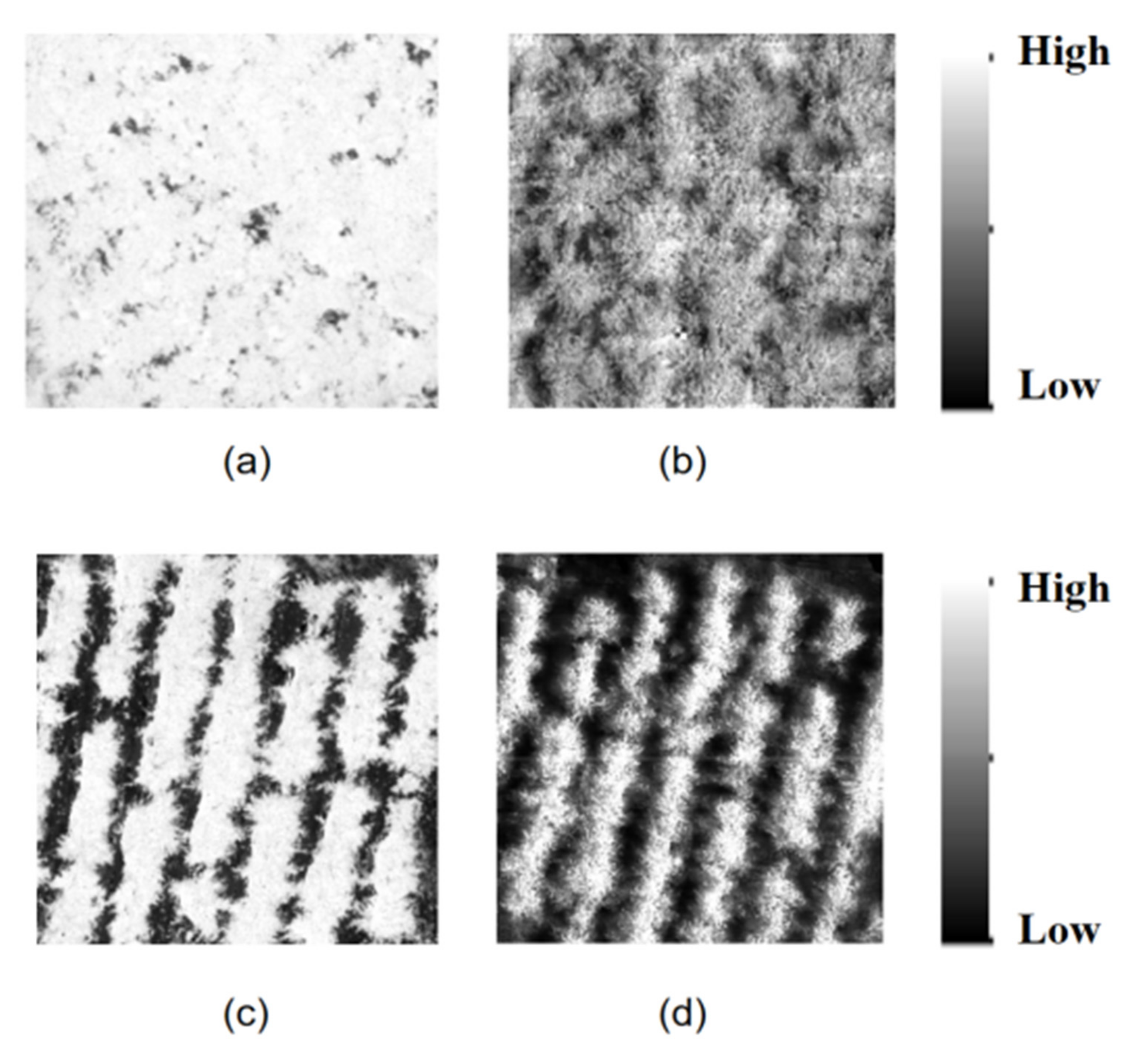
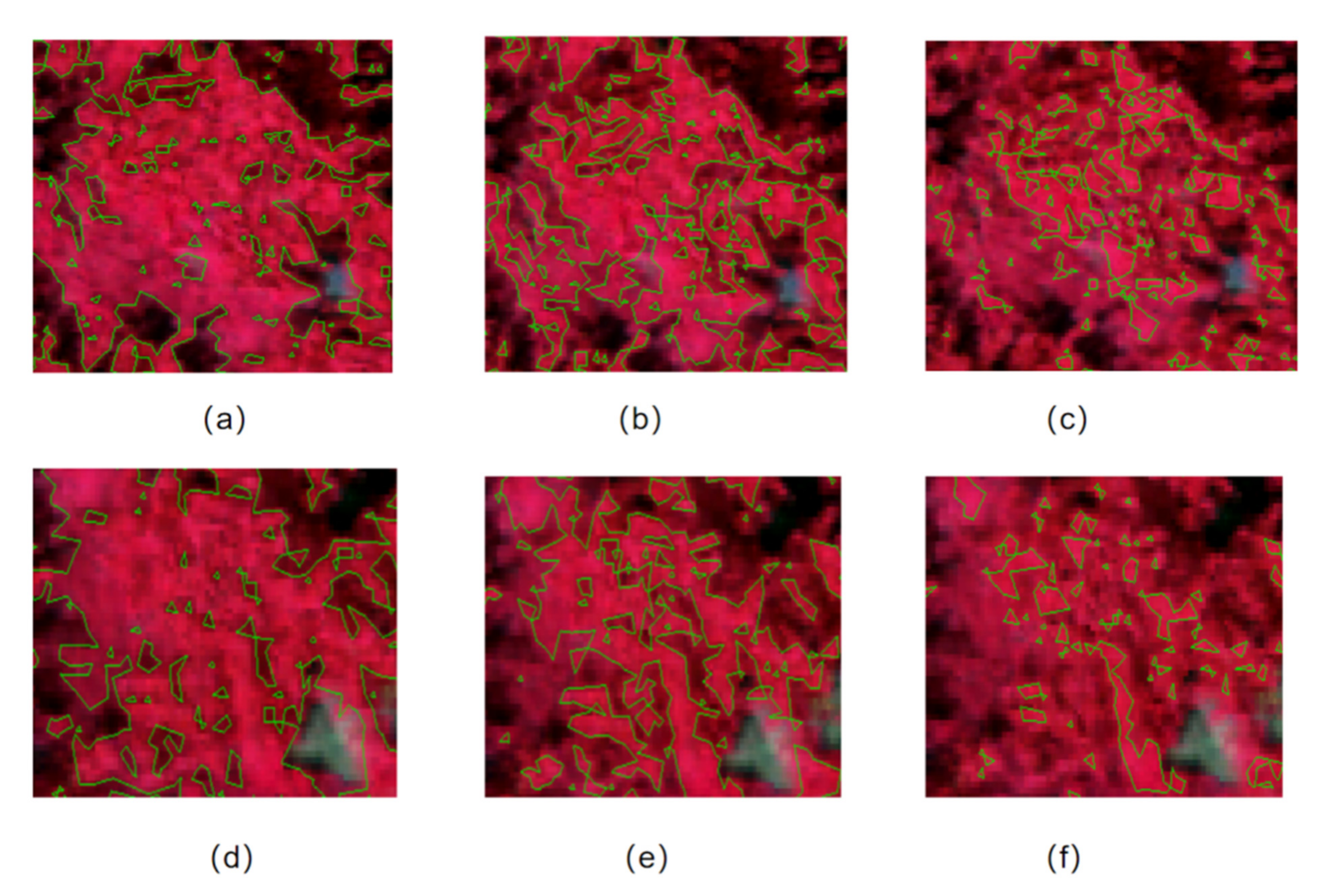
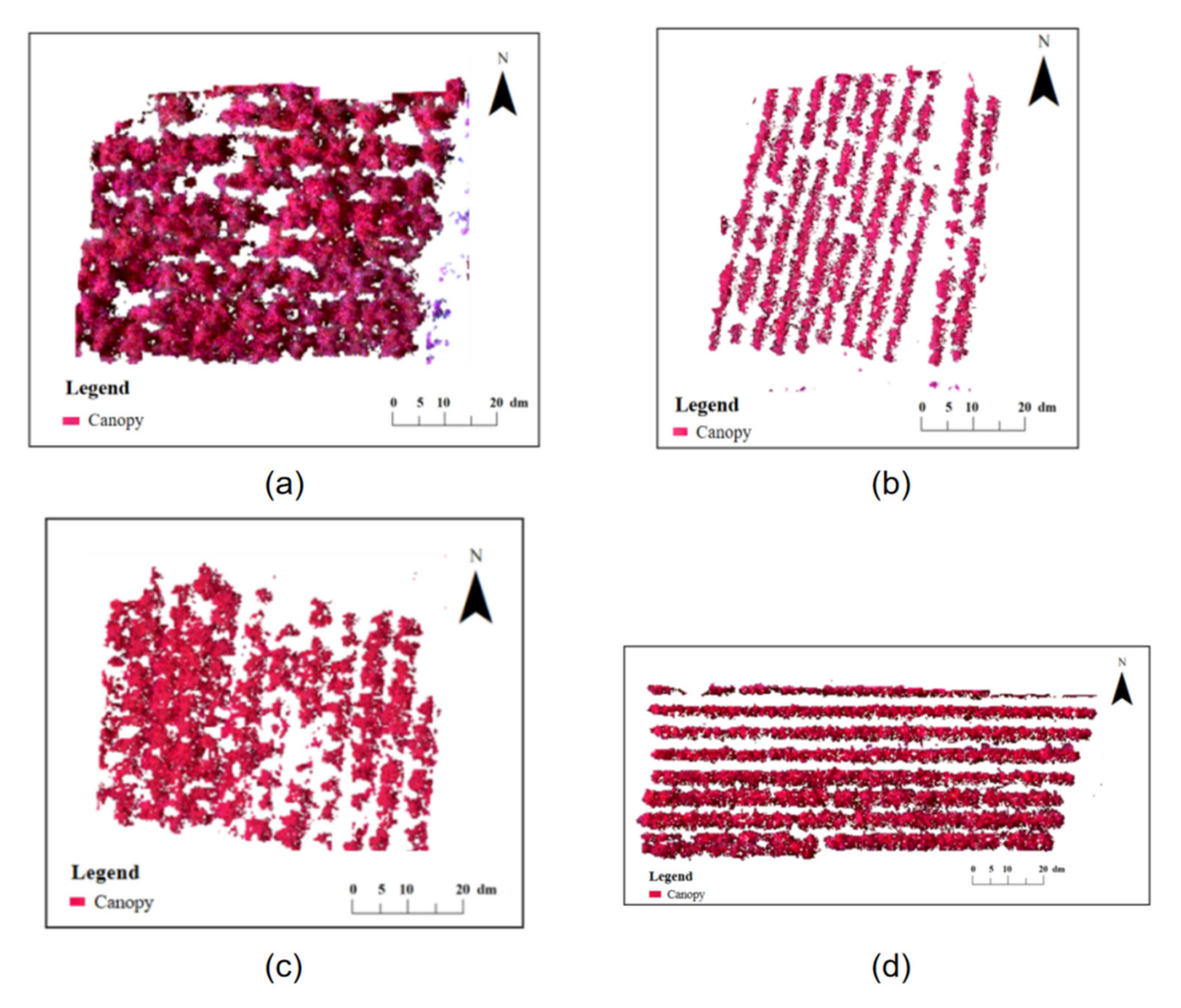
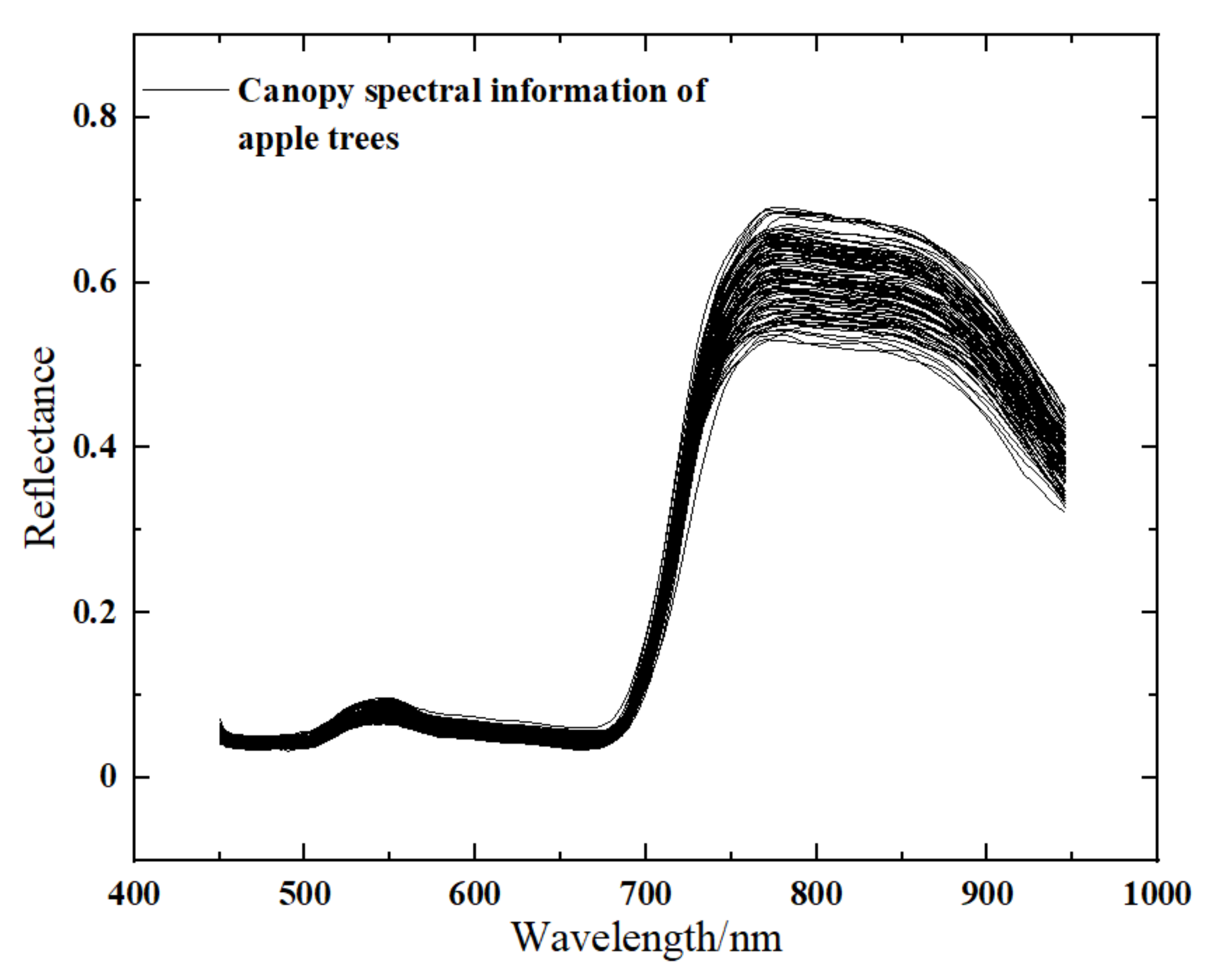
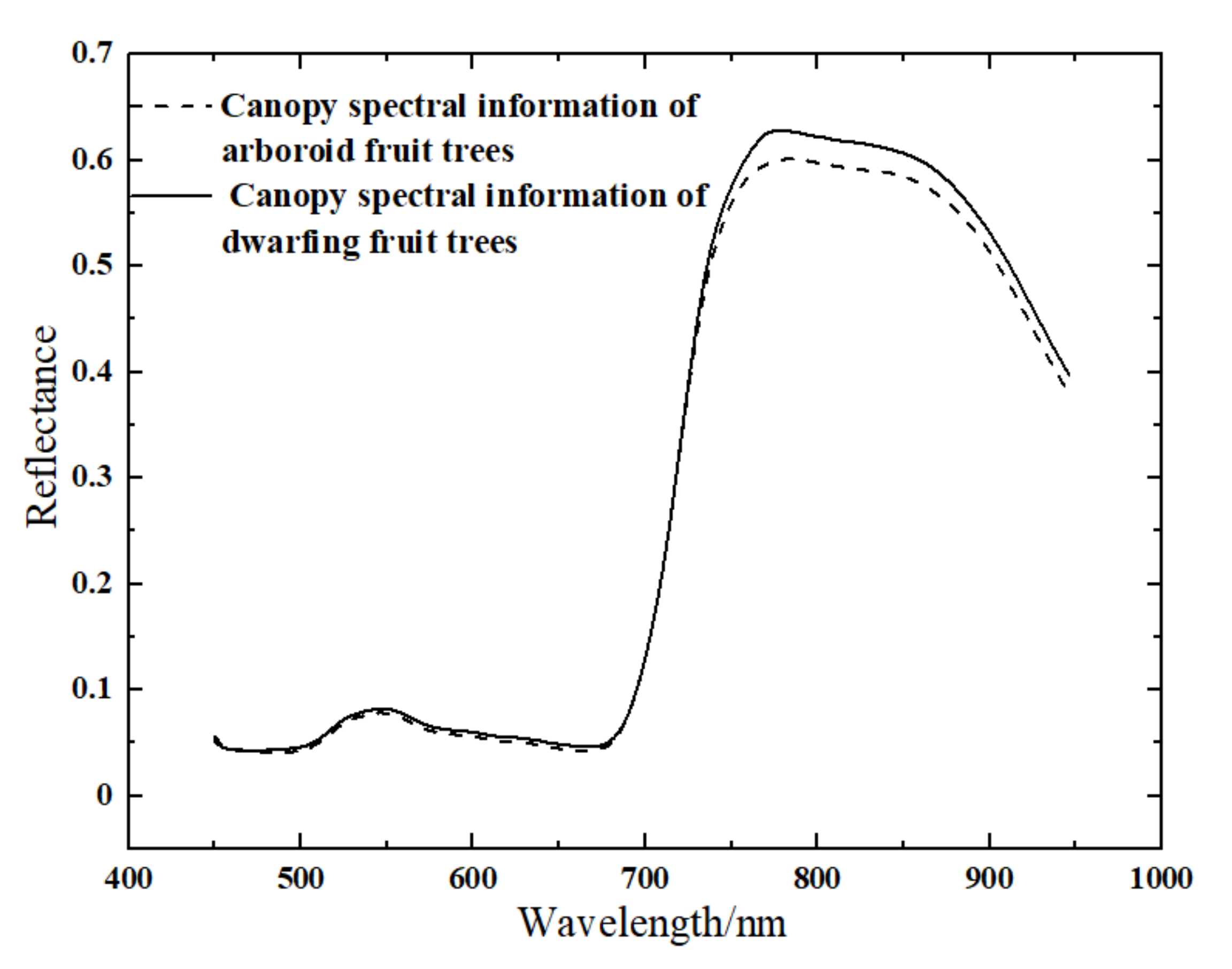
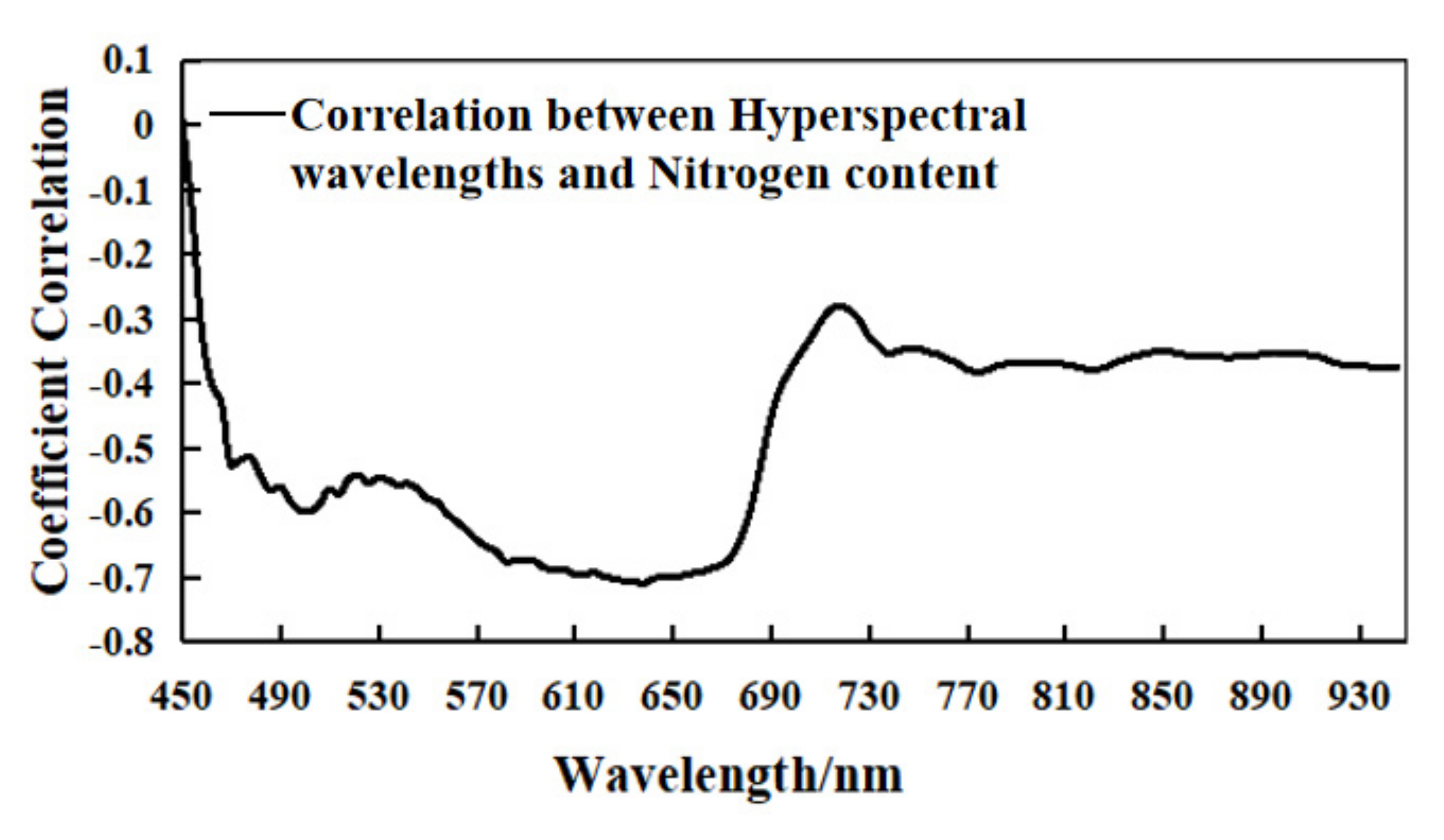
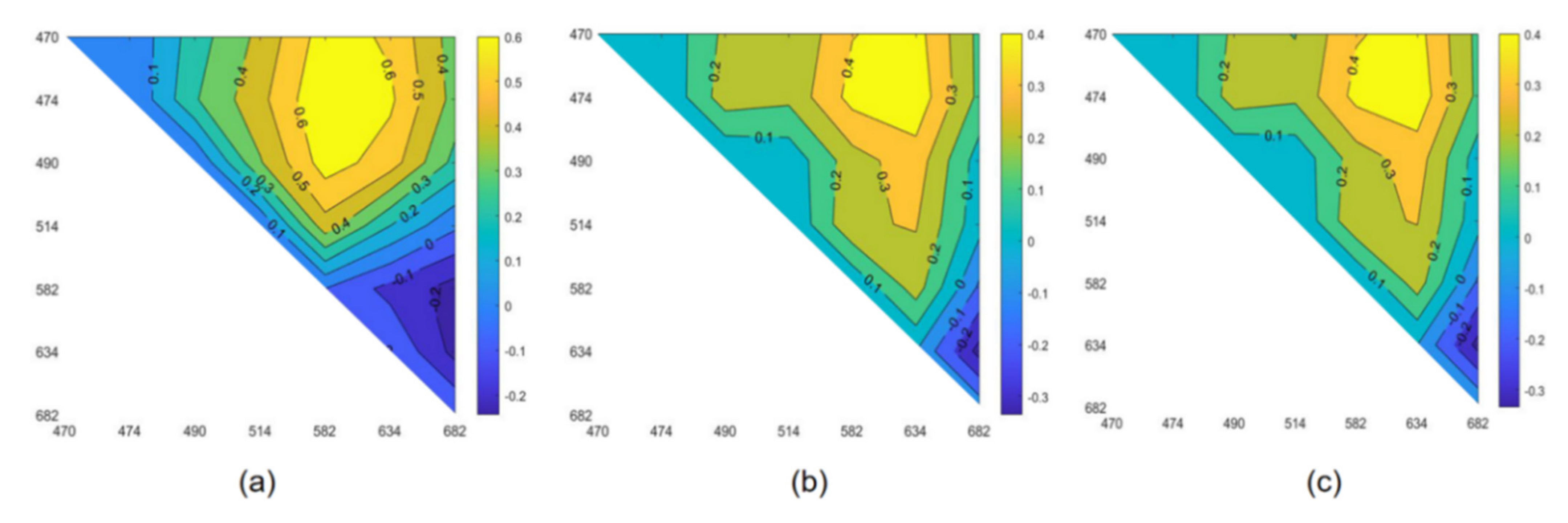
| Sample | Sample Number | Max Value/% | Min Value/% | Average Value/% | Standard Deviation |
|---|---|---|---|---|---|
| Total | 100 | 2.882 | 2.373 | 2.628 | 0.104 |
| Modelling Set | 67 | 2.882 | 2.373 | 2.621 | 0.113 |
| Validation Set | 33 | 2.798 | 2.450 | 2.642 | 0.083 |
| Degree | Gamma | Coef0 | Nu | Epsilon | Cashe size | Cost | Shrinking | Prob | p |
|---|---|---|---|---|---|---|---|---|---|
| 3 | 2 | 0.001 | 0.5 | 0.001 | 100 | 1 | 1 | 1 | 0.01 |
| Implied Network Layers | Enter the Number of Layer Nodes | Minimum Training Speed | Dynamic Parameter | SIGMOID | Allowable Error | Permission Iterative Number |
|---|---|---|---|---|---|---|
| 1 | 6 | 0.1 | 0.6 | 0.9 | 0.0001 | 1000 |
| Model Building | |||||
|---|---|---|---|---|---|
| Correlation Threshold | Sensitive Band/nm | R2 | RMSE | R2 | RMSE |
| 0.95 | 470, 474, 490, 514, 582, 634, 682 nm | 0.571 | 0.074 | 0.587 | 0.052 |
| 0.9 | 470, 510, 622, 686 nm | 0.501 | 0.080 | 0.582 | 0.053 |
| 0.85 | 470, 618, 686 nm | 0.546 | 0.081 | 0.487 | 0.055 |
| 0.8 | 470, 650 nm | 0.530 | 0.081 | 0.478 | 0.056 |
| Spectral Characteristic Parameter | Correlation Coefficient | Spectral Characteristic Parameter | Correlation Coefficient |
|---|---|---|---|
| DDI(470;474;490) | 0.525 | DDI(474;490;682) | 0.609 |
| DDI(470,474;514) | 0.544 | DDI(474;514;582) | 0.657 |
| DDI(470,474;582) | 0.649 | DDI(474;514;634) | 0.697 |
| DDI(470,474;634) | 0.672 | DDI(474;514;682) | 0.624 |
| DDI(470,474;682) | 0.569 | DDI(474;582;634) | 0.735 |
| DDI(470;490;514) | 0.560 | DDI(474;582;682) | 0.678 |
| DDI(470;490;582) | 0.659 | DDI(474;634;682) | 0.657 |
| DDI(470;490;634) | 0.678 | DDI(490;514;582) | 0.647 |
| DDI(470;490;682) | 0.591 | DDI(490;514;634) | 0.694 |
| DDI(470;514;582) | 0.641 | DDI(490;514;682) | 0.609 |
| DDI(470;514;634) | 0.677 | DDI(490;582;634) | 0.728 |
| DDI(470;514;682) | 0.605 | DDI(490;582;682) | 0.664 |
| DDI(470;582;634) | 0.718 | DDI(490;634;682) | 0.641 |
| DDI(470;634;682) | 0.662 | DDI(514;582;634) | 0.716 |
| DDI(470;634;682) | 0.642 | DDI(514;582;682) | 0.640 |
| DDI(474;490;514) | 0.579 | DDI(514;634;682) | 0.577 |
| DDI(474;490;582) | 0.678 | DDI(582;634;682) | 0.537 |
| DDI(474;490;634) | 0.701 |
| MLR | PLS | SVM | BPNN | ||
|---|---|---|---|---|---|
| Training Set | R2 | 0.643 | 0.581 | 0.733 | 0.681 |
| RMSE/% | 7.11 | 7.31 | 6.00 | 6.43 | |
| nRMSE/% | 15.29 | 18.61 | 12.76 | 17.09 | |
| MAE/% | 5.66 | 6.01 | 4.49 | 5.21 | |
| Validation set | R2 | 0.576 | 0.547 | 0.671 | 0.670 |
| RMSE/% | 6.42 | 5.53 | 4.73 | 4.64 | |
| nRMSE/% | 26.23 | 20.93 | 14.83 | 15.19 | |
| MAE/% | 5.81 | 4.20 | 3.98 | 3.60 |
Publisher’s Note: MDPI stays neutral with regard to jurisdictional claims in published maps and institutional affiliations. |
© 2022 by the authors. Licensee MDPI, Basel, Switzerland. This article is an open access article distributed under the terms and conditions of the Creative Commons Attribution (CC BY) license (https://creativecommons.org/licenses/by/4.0/).
Share and Cite
Li, M.; Zhu, X.; Li, W.; Tang, X.; Yu, X.; Jiang, Y. Retrieval of Nitrogen Content in Apple Canopy Based on Unmanned Aerial Vehicle Hyperspectral Images Using a Modified Correlation Coefficient Method. Sustainability 2022, 14, 1992. https://doi.org/10.3390/su14041992
Li M, Zhu X, Li W, Tang X, Yu X, Jiang Y. Retrieval of Nitrogen Content in Apple Canopy Based on Unmanned Aerial Vehicle Hyperspectral Images Using a Modified Correlation Coefficient Method. Sustainability. 2022; 14(4):1992. https://doi.org/10.3390/su14041992
Chicago/Turabian StyleLi, Meixuan, Xicun Zhu, Wei Li, Xiaoying Tang, Xinyang Yu, and Yuanmao Jiang. 2022. "Retrieval of Nitrogen Content in Apple Canopy Based on Unmanned Aerial Vehicle Hyperspectral Images Using a Modified Correlation Coefficient Method" Sustainability 14, no. 4: 1992. https://doi.org/10.3390/su14041992
APA StyleLi, M., Zhu, X., Li, W., Tang, X., Yu, X., & Jiang, Y. (2022). Retrieval of Nitrogen Content in Apple Canopy Based on Unmanned Aerial Vehicle Hyperspectral Images Using a Modified Correlation Coefficient Method. Sustainability, 14(4), 1992. https://doi.org/10.3390/su14041992






